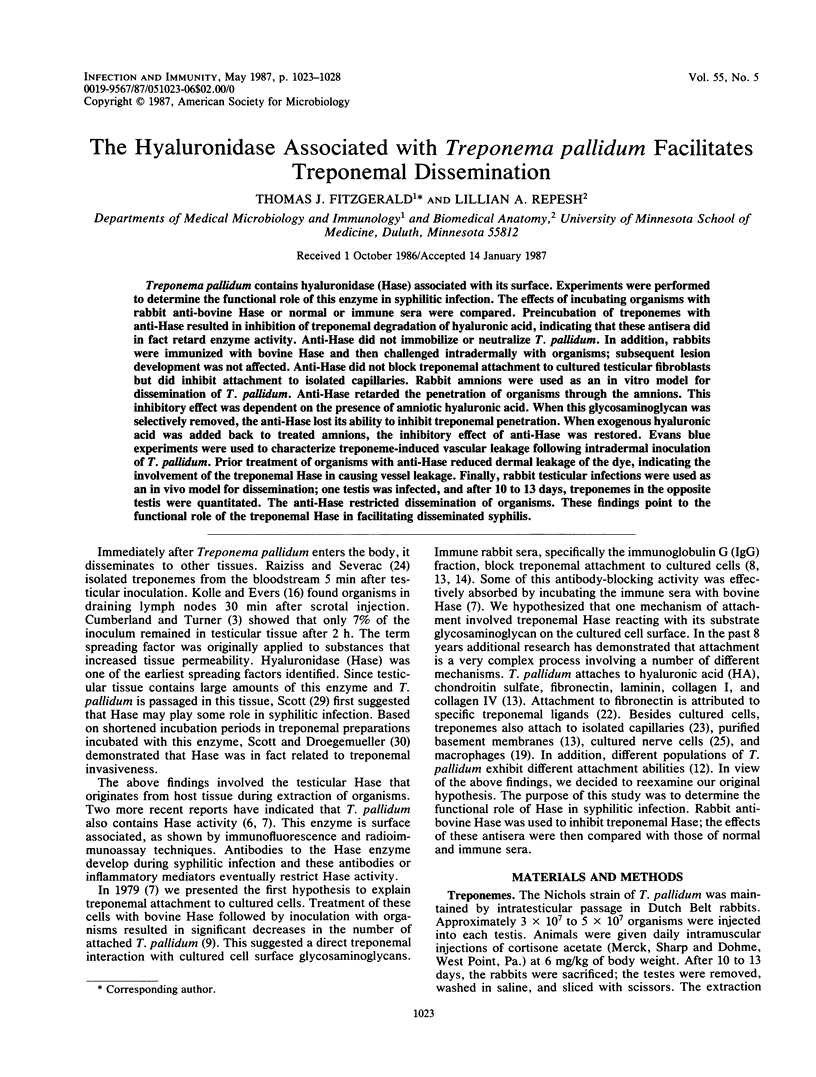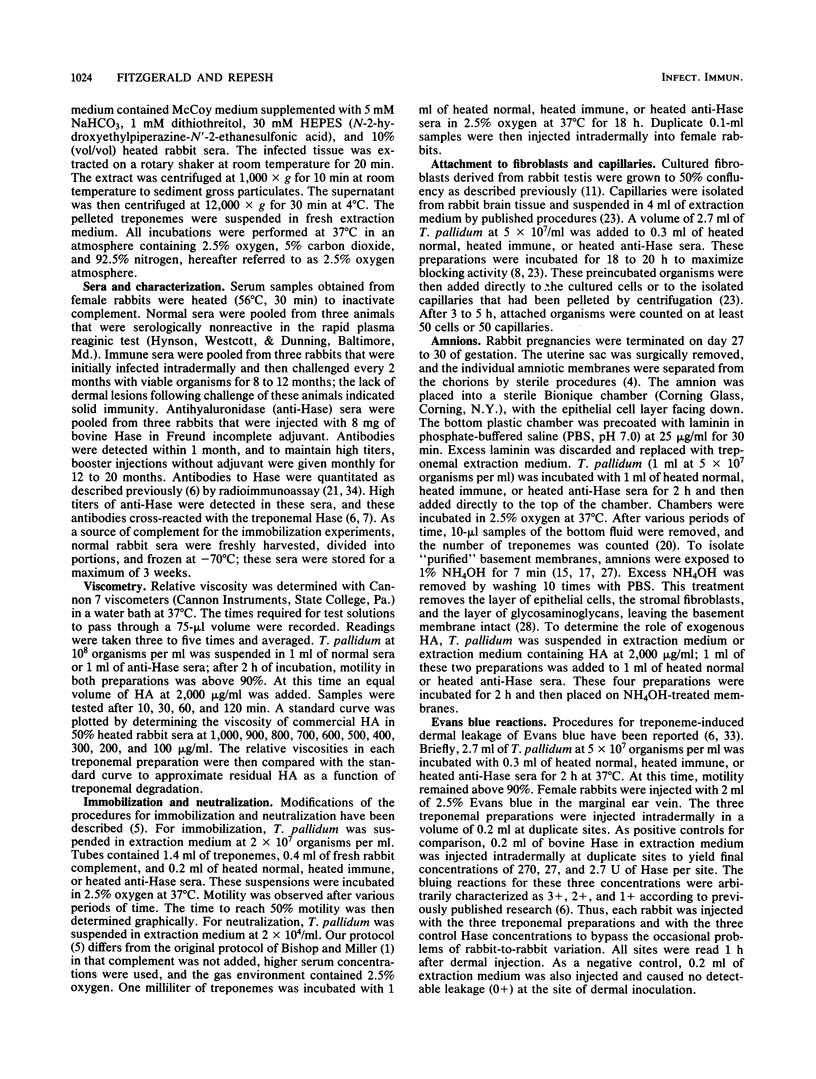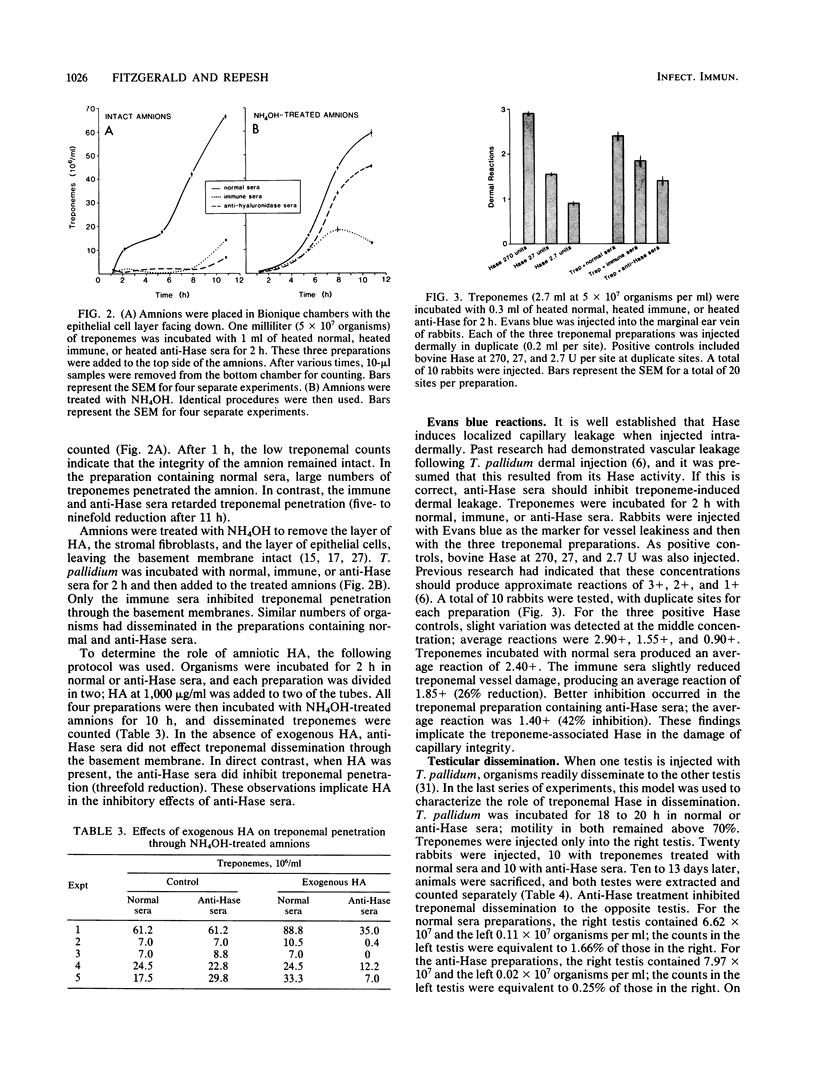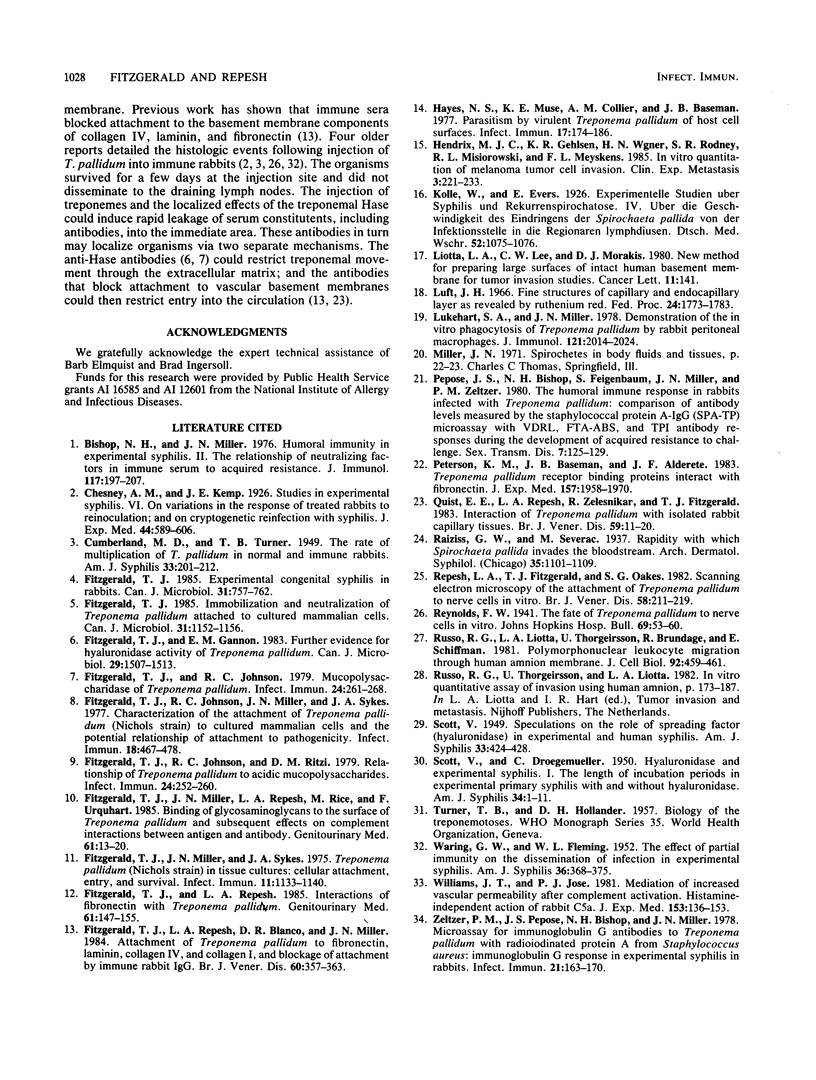Abstract
Treponema pallidum contains hyaluronidase (Hase) associated with its surface. Experiments were performed to determine the functional role of this enzyme in syphilitic infection. The effects of incubating organisms with rabbit anti-bovine Hase or normal or immune sera were compared. Preincubation of treponemes with anti-Hase resulted in inhibition of treponemal degradation of hyaluronic acid, indicating that these antisera did in fact retard enzyme activity. Anti-Hase did not immobilize or neutralize T. pallidum. In addition, rabbits were immunized with bovine Hase and then challenged intradermally with organisms; subsequent lesion development was not affected. Anti-Hase did not block treponemal attachment to cultured testicular fibroblasts but did inhibit attachment to isolated capillaries. Rabbit amnions were used as an in vitro model for dissemination of T. pallidum. Anti-Hase retarded the penetration of organisms through the amnions. This inhibitory effect was dependent on the presence of amniotic hyaluronic acid. When this glycosaminoglycan was selectively removed, the anti-Hase lost its ability to inhibit treponemal penetration. When exogenous hyaluronic acid was added back to treated amnions, the inhibitory effect of anti-Hase was restored. Evans blue experiments were used to characterize treponeme-induced vascular leakage following intradermal inoculation of T. pallidum. Prior treatment of organisms with anti-Hase reduced dermal leakage of the dye, indicating the involvement of the treponemal Hase in causing vessel leakage. Finally, rabbit testicular infections were used as an in vivo model for dissemination; one testis was infected, and after 10 to 13 days, treponemes in the opposite testis were quantitated. The anti-Hase restricted dissemination of organisms. These findings point to the functional role of the treponemal Hase in facilitating disseminated syphilis.
Full text
PDF





Selected References
These references are in PubMed. This may not be the complete list of references from this article.
- Bishop N. H., Miller J. N. Humoral immunity in experimental syphilis. II. The relationship of neutralizing factors in immune serum to acquired resistance. J Immunol. 1976 Jul;117(1):197–207. [PubMed] [Google Scholar]
- Fitzgerald T. J. Experimental congenital syphilis in rabbits. Can J Microbiol. 1985 Sep;31(9):757–762. doi: 10.1139/m85-142. [DOI] [PubMed] [Google Scholar]
- Fitzgerald T. J., Gannon E. M. Further evidence for hyaluronidase activity of Treponema pallidum. Can J Microbiol. 1983 Nov;29(11):1507–1513. doi: 10.1139/m83-232. [DOI] [PubMed] [Google Scholar]
- Fitzgerald T. J., Johnson R. C., Miller J. N., Sykes J. A. Characterization of the attachment of Treponema pallidum (Nichols strain) to cultured mammalian cells and the potential relationship of attachment to pathogenicity. Infect Immun. 1977 Nov;18(2):467–478. doi: 10.1128/iai.18.2.467-478.1977. [DOI] [PMC free article] [PubMed] [Google Scholar]
- Fitzgerald T. J., Johnson R. C. Mucopolysaccharidase of Treponema pallidum. Infect Immun. 1979 Apr;24(1):261–268. doi: 10.1128/iai.24.1.261-268.1979. [DOI] [PMC free article] [PubMed] [Google Scholar]
- Fitzgerald T. J., Johnson R. C., Ritzi D. M. Relationship of Treponema pallidum to acidic mucopolysaccharides. Infect Immun. 1979 Apr;24(1):252–260. doi: 10.1128/iai.24.1.252-260.1979. [DOI] [PMC free article] [PubMed] [Google Scholar]
- Fitzgerald T. J., Miller J. N., Repesh L. A., Rice M., Urquhart A. Binding of glycosaminoglycans to the surface of Treponema pallidum and subsequent effects on complement interactions between antigen and antibody. Genitourin Med. 1985 Feb;61(1):13–20. doi: 10.1136/sti.61.1.13. [DOI] [PMC free article] [PubMed] [Google Scholar]
- Fitzgerald T. J., Miller J. N., Sykes J. A. Treponema pallidum (Nichols strain) in tissue cultures: cellular attachment, entry, and survival. Infect Immun. 1975 May;11(5):1133–1140. doi: 10.1128/iai.11.5.1133-1140.1975. [DOI] [PMC free article] [PubMed] [Google Scholar]
- Fitzgerald T. J., Repesh L. A., Blanco D. R., Miller J. N. Attachment of Treponema pallidum to fibronectin, laminin, collagen IV, and collagen I, and blockage of attachment by immune rabbit IgG. Br J Vener Dis. 1984 Dec;60(6):357–363. doi: 10.1136/sti.60.6.357. [DOI] [PMC free article] [PubMed] [Google Scholar]
- Fitzgerald T. J., Repesh L. A. Interactions of fibronectin with Treponema pallidum. Genitourin Med. 1985 Jun;61(3):147–155. doi: 10.1136/sti.61.3.147. [DOI] [PMC free article] [PubMed] [Google Scholar]
- Fitzgerald T. Immobilization and neutralization of Treponema pallidum attached to cultured mammalian cells. Can J Microbiol. 1985 Dec;31(12):1152–1156. doi: 10.1139/m85-217. [DOI] [PubMed] [Google Scholar]
- Hayes N. S., Muse K. E., Collier A. M., Baseman J. B. Parasitism by virulent Treponema pallidum of host cell surfaces. Infect Immun. 1977 Jul;17(1):174–186. doi: 10.1128/iai.17.1.174-186.1977. [DOI] [PMC free article] [PubMed] [Google Scholar]
- Hendrix M. J., Gehlsen K. R., Wagner H. N., Jr, Rodney S. R., Misiorowski R. L., Meyskens F. L., Jr In vitro quantification of melanoma tumor cell invasion. Clin Exp Metastasis. 1985 Oct-Dec;3(4):221–233. doi: 10.1007/BF01585078. [DOI] [PubMed] [Google Scholar]
- Liotta L. A., Lee C. W., Morakis D. J. New method for preparing large surfaces of intact human basement membrane for tumor invasion studies. Cancer Lett. 1980 Dec;11(2):141–152. doi: 10.1016/0304-3835(80)90105-6. [DOI] [PubMed] [Google Scholar]
- Luft J. H. Fine structures of capillary and endocapillary layer as revealed by ruthenium red. Fed Proc. 1966 Nov-Dec;25(6):1773–1783. [PubMed] [Google Scholar]
- Lukehart S. A., Miller J. N. Demonstration of the in vitro phagocytosis of Treponema pallidum by rabbit peritoneal macrophages. J Immunol. 1978 Nov;121(5):2014–2024. [PubMed] [Google Scholar]
- Pepose J. S., Bishop N. H., Feigenbaum S., Miller J. N., Zeltzer P. M. The humoral immune response in rabbits infected with Treponema pallidum: Comparison of antibody levels measured by the staphylococcal protein A-IgG (SPA-TP) microassay with VDRL, FTA-Abs, and TPI antibody responses during the development of acquired resistance to challenge. Sex Transm Dis. 1980 Jul-Sep;7(3):125–129. [PubMed] [Google Scholar]
- Peterson K. M., Baseman J. B., Alderete J. F. Treponema pallidum receptor binding proteins interact with fibronectin. J Exp Med. 1983 Jun 1;157(6):1958–1970. doi: 10.1084/jem.157.6.1958. [DOI] [PMC free article] [PubMed] [Google Scholar]
- Quist E. E., Repesh L. A., Zeleznikar R., Fitzgerald T. J. Interaction of Treponema pallidum with isolated rabbit capillary tissues. Br J Vener Dis. 1983 Feb;59(1):11–20. doi: 10.1136/sti.59.1.11. [DOI] [PMC free article] [PubMed] [Google Scholar]
- Repesh L. A., Fitzgerald T. J., Oakes S. G., Pozos R. S. Scanning electron microscopy of the attachment of Treponema pallidum to nerve cells in vitro. Br J Vener Dis. 1982 Aug;58(4):211–219. doi: 10.1136/sti.58.4.211. [DOI] [PMC free article] [PubMed] [Google Scholar]
- Russo R. G., Liotta L. A., Thorgeirsson U., Brundage R., Schiffmann E. Polymorphonuclear leukocyte migration through human amnion membrane. J Cell Biol. 1981 Nov;91(2 Pt 1):459–467. doi: 10.1083/jcb.91.2.459. [DOI] [PMC free article] [PubMed] [Google Scholar]
- SCOTT V., DROEGEMUELLER C. Hyaluronidase and experimental syphilis; the length of incubation periods in experimental primary syphilis with and without hyaluronidase. Am J Syph Gonorrhea Vener Dis. 1950 Jan;34(1):1–11. [PubMed] [Google Scholar]
- WARING G. W., Jr, FLEMING W. L. The effect of partial immunity on the dissemination of infection in experimental syphilis. Am J Syph Gonorrhea Vener Dis. 1952 Jul;36(4):368–375. [PubMed] [Google Scholar]
- Williams T. J., Jose P. J. Mediation of increased vascular permeability after complement activation. Histamine-independent action of rabbit C5a. J Exp Med. 1981 Jan 1;153(1):136–153. doi: 10.1084/jem.153.1.136. [DOI] [PMC free article] [PubMed] [Google Scholar]
- Zeltzer P. M., Pepose J. S., Bishop N. H., Miller J. N. Microassay for immunoglobulin G antibodies to Treponema pallidum with radioiodinated protein A from staphylococcus aureus: immunoglobulin G response in experimental syphilis in rabbits. Infect Immun. 1978 Jul;21(1):163–170. doi: 10.1128/iai.21.1.163-170.1978. [DOI] [PMC free article] [PubMed] [Google Scholar]


